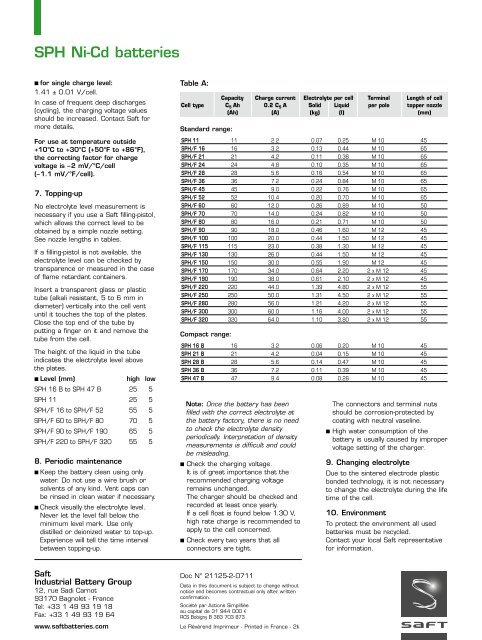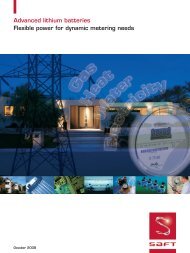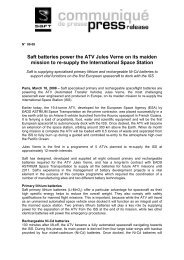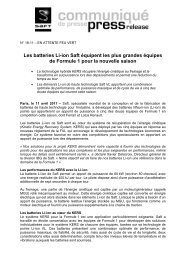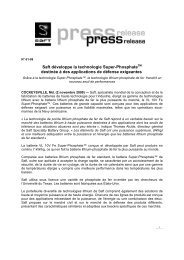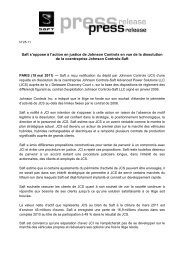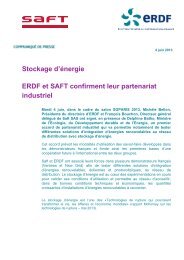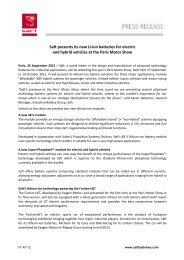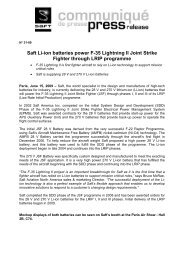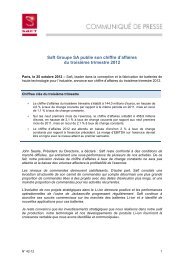SPH Ni-Cd batteries - Saft
SPH Ni-Cd batteries - Saft
SPH Ni-Cd batteries - Saft
You also want an ePaper? Increase the reach of your titles
YUMPU automatically turns print PDFs into web optimized ePapers that Google loves.
<strong>SPH</strong> <strong>Ni</strong>-<strong>Cd</strong> <strong>batteries</strong><br />
■ for single charge level:<br />
1.41 ± 0.01 V/cell.<br />
In case of frequent deep discharges<br />
(cycling), the charging voltage values<br />
should be increased. Contact <strong>Saft</strong> for<br />
more details.<br />
For use at temperature outside<br />
+10°C to +30°C (+50°F to +86°F),<br />
the correcting factor for charge<br />
voltage is –2 mV/°C/cell<br />
(–1.1 mV/°F/cell).<br />
7. Topping-up<br />
No electrolyte level measurement is<br />
necessary if you use a <strong>Saft</strong> filling-pistol,<br />
which allows the correct level to be<br />
obtained by a simple nozzle setting.<br />
See nozzle lengths in tables.<br />
If a filling-pistol is not available, the<br />
electrolyte level can be checked by<br />
transparence or measured in the case<br />
of flame retardant containers.<br />
Insert a transparent glass or plastic<br />
tube (alkali resistant, 5 to 6 mm in<br />
diameter) vertically into the cell vent<br />
until it touches the top of the plates.<br />
Close the top end of the tube by<br />
putting a finger on it and remove the<br />
tube from the cell.<br />
The height of the liquid in the tube<br />
indicates the electrolyte level above<br />
the plates.<br />
■ Level (mm) high low<br />
<strong>SPH</strong> 16 B to <strong>SPH</strong> 47 B 25 5<br />
<strong>SPH</strong> 11 25 5<br />
<strong>SPH</strong>/F 16 to <strong>SPH</strong>/F 52 55 5<br />
<strong>SPH</strong>/F 60 to <strong>SPH</strong>/F 80 70 5<br />
<strong>SPH</strong>/F 90 to <strong>SPH</strong>/F 190 65 5<br />
<strong>SPH</strong>/F 220 to <strong>SPH</strong>/F 320 55 5<br />
8. Periodic maintenance<br />
■ Keep the battery clean using only<br />
water. Do not use a wire brush or<br />
solvents of any kind. Vent caps can<br />
be rinsed in clean water if necessary.<br />
■ Check visually the electrolyte level.<br />
Never let the level fall below the<br />
minimum level mark. Use only<br />
distilled or deionized water to top-up.<br />
Experience will tell the time interval<br />
between topping-up.<br />
<strong>Saft</strong><br />
Industrial Battery Group<br />
12, rue Sadi Carnot<br />
93170 Bagnolet - France<br />
Tel: +33 1 49 93 19 18<br />
Fax: +33 1 49 93 19 64<br />
www.saft<strong>batteries</strong>.com<br />
Table A:<br />
Capacity Charge current Electrolyte per cell Terminal Length of cell<br />
Cell type C 5 Ah 0.2 C 5 A Solid Liquid per pole topper nozzle<br />
(Ah) (A) (kg) (l) (mm)<br />
Standard range:<br />
<strong>SPH</strong> 11 11 2.2 0.07 0.25 M 10 45<br />
<strong>SPH</strong>/F 16 16 3.2 0.13 0.44 M 10 65<br />
<strong>SPH</strong>/F 21 21 4.2 0.11 0.38 M 10 65<br />
<strong>SPH</strong>/F 24 24 4.8 0.10 0.35 M 10 65<br />
<strong>SPH</strong>/F 28 28 5.6 0.16 0.54 M 10 65<br />
<strong>SPH</strong>/F 36 36 7.2 0.24 0.84 M 10 65<br />
<strong>SPH</strong>/F 45 45 9.0 0.22 0.76 M 10 65<br />
<strong>SPH</strong>/F 52 52 10.4 0.20 0.70 M 10 65<br />
<strong>SPH</strong>/F 60 60 12.0 0.26 0.89 M 10 50<br />
<strong>SPH</strong>/F 70 70 14.0 0.24 0.82 M 10 50<br />
<strong>SPH</strong>/F 80 80 16.0 0.21 0.71 M 10 50<br />
<strong>SPH</strong>/F 90 90 18.0 0.46 1.60 M 12 45<br />
<strong>SPH</strong>/F 100 100 20.0 0.44 1.50 M 12 45<br />
<strong>SPH</strong>/F 115 115 23.0 0.38 1.30 M 12 45<br />
<strong>SPH</strong>/F 130 130 26.0 0.44 1.50 M 12 45<br />
<strong>SPH</strong>/F 150 150 30.0 0.55 1.90 M 12 45<br />
<strong>SPH</strong>/F 170 170 34.0 0.64 2.20 2 x M 12 45<br />
<strong>SPH</strong>/F 190 190 38.0 0.61 2.10 2 x M 12 45<br />
<strong>SPH</strong>/F 220 220 44.0 1.39 4.80 2 x M 12 55<br />
<strong>SPH</strong>/F 250 250 50.0 1.31 4.50 2 x M 12 55<br />
<strong>SPH</strong>/F 280 280 56.0 1.21 4.20 2 x M 12 55<br />
<strong>SPH</strong>/F 300 300 60.0 1.16 4.00 2 x M 12 55<br />
<strong>SPH</strong>/F 320 320 64.0 1.10 3.80 2 x M 12 55<br />
Compact range:<br />
<strong>SPH</strong> 16 B 16 3.2 0.06 0.20 M 10 45<br />
<strong>SPH</strong> 21 B 21 4.2 0.04 0.15 M 10 45<br />
<strong>SPH</strong> 28 B 28 5.6 0.14 0.47 M 10 45<br />
<strong>SPH</strong> 36 B 36 7.2 0.11 0.39 M 10 45<br />
<strong>SPH</strong> 47 B 47 9.4 0.08 0.28 M 10 45<br />
Note: Once the battery has been<br />
filled with the correct electrolyte at<br />
the battery factory, there is no need<br />
to check the electrolyte density<br />
periodically. Interpretation of density<br />
measurements is difficult and could<br />
be misleading.<br />
■ Check the charging voltage.<br />
It is of great importance that the<br />
recommended charging voltage<br />
remains unchanged.<br />
The charger should be checked and<br />
recorded at least once yearly.<br />
If a cell float is found below 1.30 V,<br />
high rate charge is recommended to<br />
apply to the cell concerned.<br />
■ Check every two years that all<br />
connectors are tight.<br />
Doc N° 21125-2-0711<br />
Data in this document is subject to change without<br />
notice and becomes contractual only after written<br />
confirmation.<br />
Société par Actions Simplifiée<br />
au capital de 31 944 000 �<br />
RCS Bobigny B 383 703 873<br />
Le Révérend Imprimeur - Printed in France - 2k<br />
The connectors and terminal nuts<br />
should be corrosion-protected by<br />
coating with neutral vaseline.<br />
■ High water consumption of the<br />
battery is usually caused by improper<br />
voltage setting of the charger.<br />
9. Changing electrolyte<br />
Due to the sintered electrode plastic<br />
bonded technology, it is not necessary<br />
to change the electrolyte during the life<br />
time of the cell.<br />
10. Environment<br />
To protect the environment all used<br />
<strong>batteries</strong> must be recycled.<br />
Contact your local <strong>Saft</strong> representative<br />
for information.


